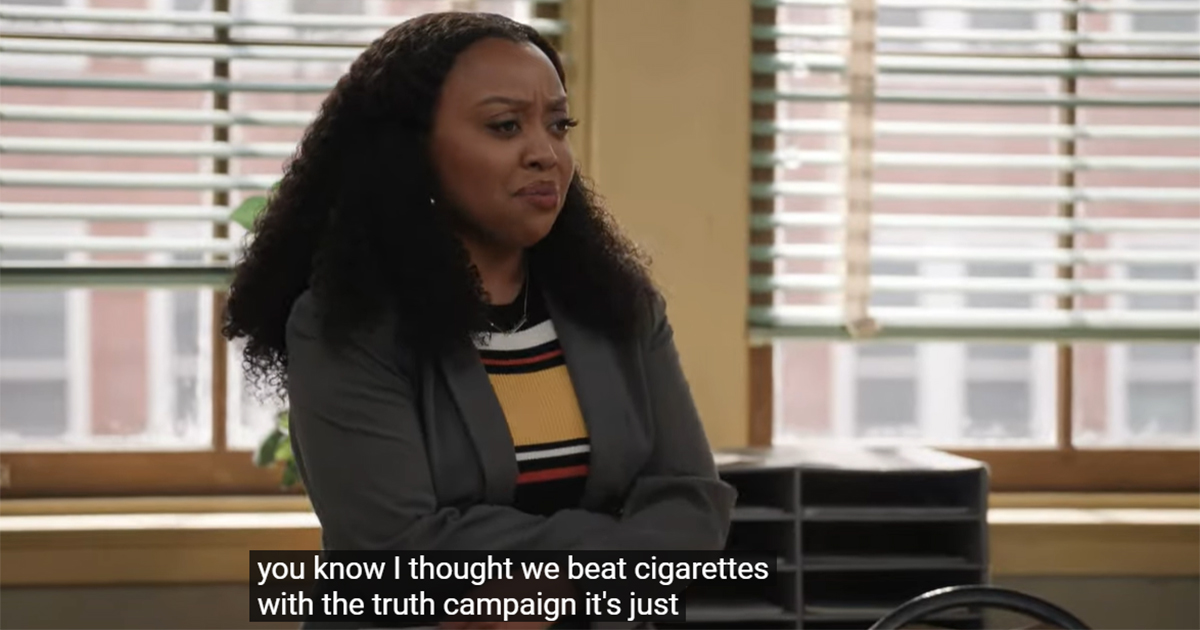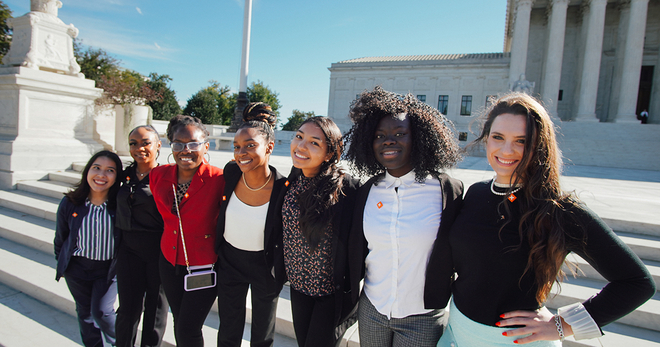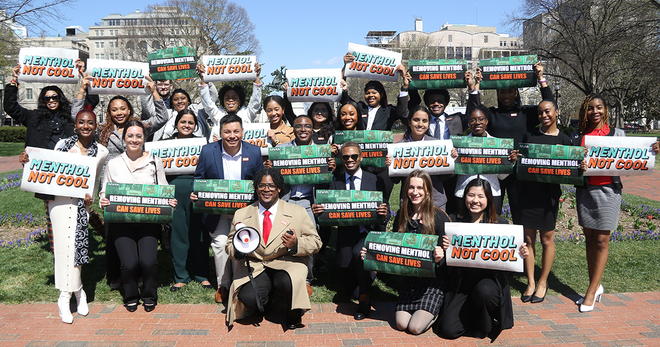“Abbott Elementary” highlights truth campaign, educators’ role in preventing youth tobacco use
An episode of “Abbott Elementary,” the popular sitcom about educators at a public school in Philadelphia, highlights the impact of the truth campaign and calls attention to how tobacco use continues to impact the health of youth nationwide – and what educators can do to help.
“I thought the truth campaign solved this,” says the show’s main character, Janine Teagues, after a student named Curtis is caught smoking in a bathroom on campus in the episode titled “Smoking” that aired earlier this year.

Janine, played by Quinta Brunson, isn’t completely wrong: truth did help drive down youth smoking prevalence from 23% in 2000 to a historic low of 2% in 2022. We’re flattered by the unsolicited shout-out, however, the issue is far from solved. New tobacco products such as flavored e-cigarettes that appeal to youth threaten to reverse years of progress toward ending youth nicotine addiction.
Schools play a central role confronting and addressing youth tobacco use, but Truth Initiative research shows that many educators didn’t feel they were trained to address the issue.
Here are three suggestions for how best to address student tobacco use at school, informed by the staff and students of Abbott Elementary.
1. Respond to students who use tobacco with support, not punishment
How to handle students who are smoking or vaping
Principal Ava Coleman of Abbott Elementary, played by Janelle James, announces that the school district is reinstating a punitive policy in response to the incident of youth tobacco use on campus. She tells teachers that the policy means she must suspend Curtis.
“This seems like overkill to do all this without even having an honest conversation with Curtis or any of our students,” Janine says. The teachers decide to reconsider the situation and have a genuine chat with Curtis.
Although vaping in schools may be frustrating for educators, it is important that teachers respond to violations with a supportive approach. Nicotine is addictive and can impact the developing brain, and it’s backed by a well-funded industry that pushes its products into young people’s hands.
Truth Initiative does not support suspension or expulsions from school as a punishment for tobacco use, including vaping, on school grounds. Suspension can cause even more problems at school, leading to lower test scores and graduation rates, among other poor outcomes. There’s also reason for concern due to well-documented disparities in suspension and expulsions among Black, Latino, and other minority students, who are far more likely to receive such punitive actions.
2. Introduce all students to a tobacco use prevention program
Vaping curriculum for educators
On “Abbott Elementary” the incident of youth tobacco use on campus leads to an intervention led by an organization called FADE (Friends Against Drug Exposure). Unfortunately, FADE’s presentation is ineffective at engaging the student body, although hilarious for viewers of the sitcom.
For real-life educators, this is where truth can step in. Vaping: Know the truth is a national youth vaping prevention curriculum for middle and high school students that gives young people the facts about e-cigarette use and provides resources to quit. It was developed by Truth Initiative and Kaiser Permanente in collaboration with the American Heart Association, and is available for free through the leading social impact education innovator EVERFI.
A peer-reviewed Truth Initiative study found the online course significantly increased e-cigarette knowledge among youth participants. The course includes the history of tobacco and nicotine use and how the tobacco industry has targeted young people.
Vaping: Know the truth was developed to be a positive, modern approach to guide teachers and educate youth about these products and their risks. It is intended to be used in the classroom to help all students. It is not intended as a remedial program or a punishment for those caught vaping or using other tobacco products on school grounds.
3. Introduce all students to a quit tobacco program
Quit vaping program for students
Schools should also provide resources about services that can help young people quit. This is Quitting, the first-of-its-kind, free and anonymous texting program from truth, is designed to help young people quit vaping nicotine and has become a resource for over 700,000 youth and young adults. The program incorporates messages from others in the same age group who have attempted to or successfully quit vaping.
A randomized clinical trial found that young adults ages 18-24 who used This is Quitting had nearly 40% higher odds of quitting compared to a control group. A second clinical trial proved that This is Quitting is not only successful in helping young people quit vaping, but also in ensuring that they don’t later use combustible tobacco products in place of e-cigarettes. To enroll, teens and young adults can text DITCHIT to 88709.
In addition, another truth program called EX can help adults who want to quit tobacco, such as “Abbott Elementary” teacher Jacob Hill, played by Chris Perfetti, who vapes and decides to quit after seeing firsthand how tobacco use can impact young people.
EX is a free, digital quit-tobacco plan and online community of thousands of current and former tobacco users developed by Truth Initiative in collaboration with Mayo Clinic. It has helped more than 910,000 people develop the skills and confidence to successfully quit. Research has shown that following the EX quit plan quadruples a tobacco user’s chance of quitting. Adults ages 25 and older can register for free at BecomeAnEX.com.
More in tobacco prevention efforts
Want support quitting? Join EX Program
By clicking JOIN, you agree to the Terms, Text Message Terms and Privacy Policy.
Msg&Data rates may apply; msgs are automated.



